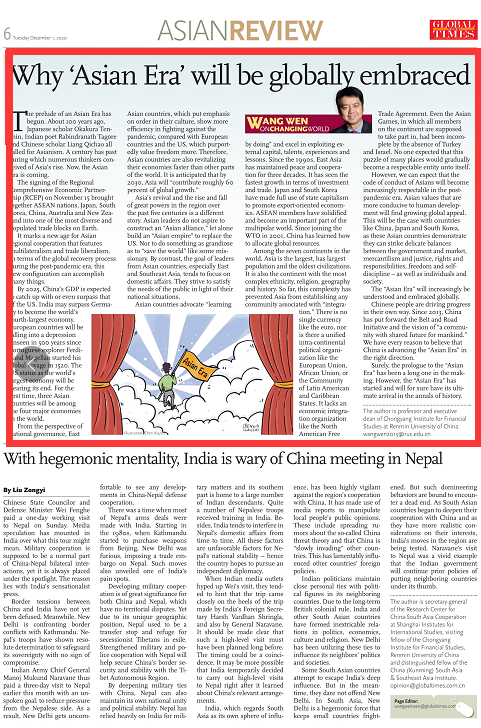Picture
Your Present Location: HOME> PictureWang Wen: Why ‘Asian Era’ will be globally embraced
By Wang Wen Source: Global Times Published: 2020-11-30

The prelude of an Asian Era has begun. About 100 years ago, Japanese scholar Okakura Tenshin, Indian poet Rabindranath Tagore and Chinese scholar Liang Qichao all called for Asianism. A century has past during which numerous thinkers have conceived of Asia's rise. Now, the Asian Era is coming.
The signing of the Regional Comprehensive Economic Partnership (RCEP) on November 15 brought together ASEAN nations, Japan, South Korea, China, Australia and New Zealand into one of the most diverse and populated trade blocks on Earth.
It marks a new age for Asian regional cooperation that features multilateralism and trade liberalism. In terms of the global recovery process during the post-pandemic era, this new configuration can accomplish many things.
By 2025, China's GDP is expected to catch up with or even surpass that of the US. India may surpass Germany to become the world's fourth-largest economy. European countries will be falling into a depression unseen in 500 years since Portuguese explorer Ferdinand Magellan started his global voyage in 1520. The US' status as the world's largest economy will be nearing its end. For the first time, three Asian countries will be among the four major economies in the world.
From the perspective of national governance, East Asian countries, which put emphasis on order in their culture, show more efficiency in fighting against the pandemic, compared with European countries and the US, which purportedly value freedom more. Therefore, Asian countries are also revitalizing their economies faster than other parts of the world. It is anticipated that by 2030, Asia will, "contribute roughly 60 percent of global growth."
Asia's revival and the rise and fall of great powers in the region over the past five centuries is a different story. Asian leaders do not aspire to construct an "Asian alliance," let alone build an "Asian empire" to replace the US. Nor to do something as grandiose as to "save the world" like some missionary. By contrast, the goal of leaders from Asian countries, especially East and Southeast Asia, tends to focus on domestic affairs. They strive to satisfy the needs of the public in light of their national situations.
Asian countries advocate "learning by doing" and excel in exploiting external capital, talents, experiences and lessons. Since the 1990s, East Asia has maintained peace and cooperation for three decades. It has seen the fastest growth in terms of investment and trade. Japan and South Korea have made full use of state capitalism to promote export-oriented economics. ASEAN members have solidified and become an important part of the multi-polar world. Since joining the WTO in 2001, China has learned how to allocate global resources.
Among the seven continents in the world, Asia is the largest, has largest population and the oldest civilizations. It is also the continent with the most complex ethnicities, religion, geography and history. So far, this complexity has prevented Asia from establishing any community associated with "integration." There is no single currency like the Euro, nor is there a unified intra-continental political organization like the European Union, African Union, or the Community of Latin American and Caribbean States. It lacks an economic integration organization like the North American Free Trade Agreement. Even the Asian Games, in which all members on the continent are supposed to take part in, had been incomplete by the absence of Turkey and Israel. No one expected that this puzzle of many places would gradually become a respectable entity unto itself.
However, we can expect that the code of conduct of Asians will become increasingly respectable in the post-pandemic era. Asian values that are more conducive to human development will find growing global appeal. This will be the case with countries like China, Japan and South Korea as these Asian countries demonstrate they can strike delicate balances between the government and market, mercantilism and justice, rights and responsibilities, freedom and self-discipline - as well as individuals and society.
As Indian American scholar Parag Khanna says in his new book, The Future Is Asian, "in the 19th century, the world was Europeanized. In the 20th century, it was Americanized. Now, in the 21st century, the world is being irreversibly Asianized."
There are another two books that I also recommend. One is The New Asian Hemisphere: The Irresistible Shift of Global Power to the East, written by Kishore Mahbubani, former dean of the Lee Kuan Yew School of Public Policy at National University of Singapore. Another is Easternization: Asia's Rise and America's Decline From Obama to Trump and Beyond written by Gideon Rachman, chief foreign affairs columnist for the Financial Times.
The "Asian Era" will increasingly be understood and embraced globally.
Chinese people are driving progress in their own way. Since 2013, China has put forward the Belt and Road Initiative and the vision of "a community with shared future for mankind." We have every reason to believe that China is advancing the "Asian Era" in the right direction.
Surely, the prologue to the "Asian era" has been a long one in the making. Yet this reminds me of the spirit of perseverance of Yu Gong, a figure from an ancient Chinese story called The Foolish Old Man Removes the Mountains, or Yu Gong Yi Shan in Chinese. In the story, the 90-year-old Yu Gong's perseverance and hard work to remove the mountain in front of his house along with his descendants moves a God, who finally orders the mountains separated.
I believe Asian countries also have Yu Gong's spirit. The "Asian Era" has started and will for sure have its ultimate arrival in the annals of history.
Wang Wen (Executive Dean of RDCY, and Executive Director of the China-U.S. People-to-People Exchange Research Center at Renmin University of China)
Please Find us : Facebook: RDCYINST Twitter: RDCYINST LinkedIn: 人大重阳RDCY Instagram:rdcyinst
Key Words: Asian Era;Wang Wen;China's GDP























































































 京公网安备 11010802037854号
京公网安备 11010802037854号





